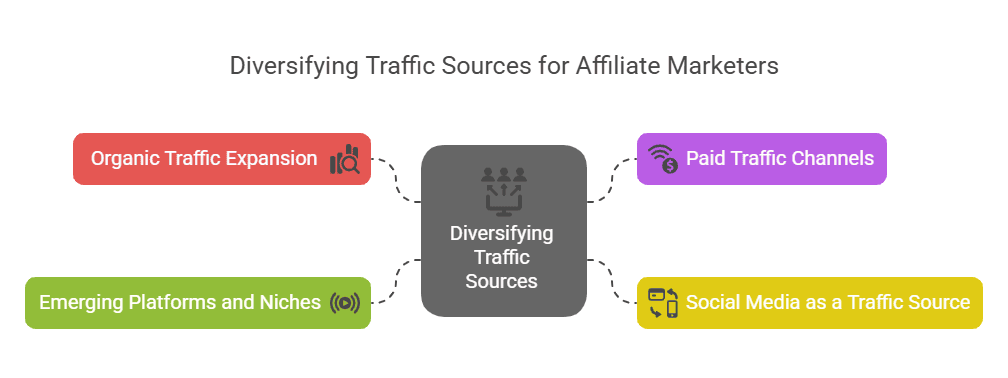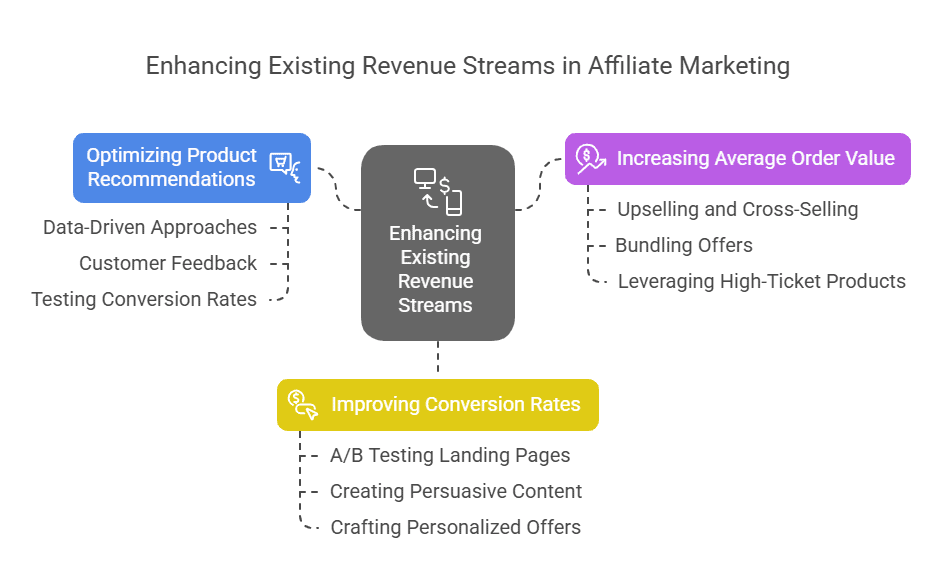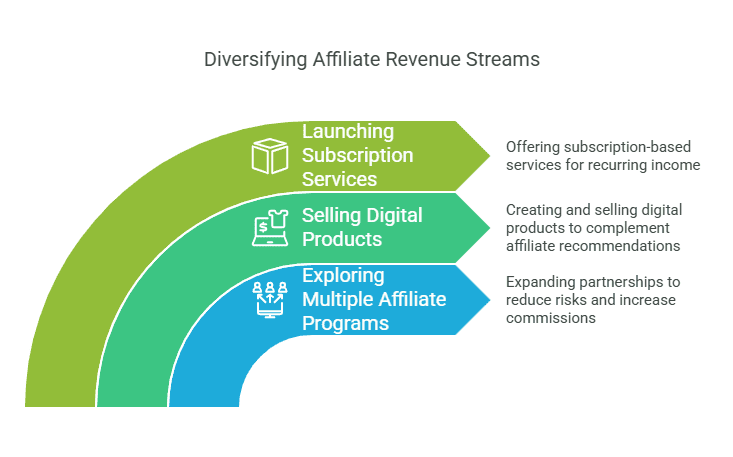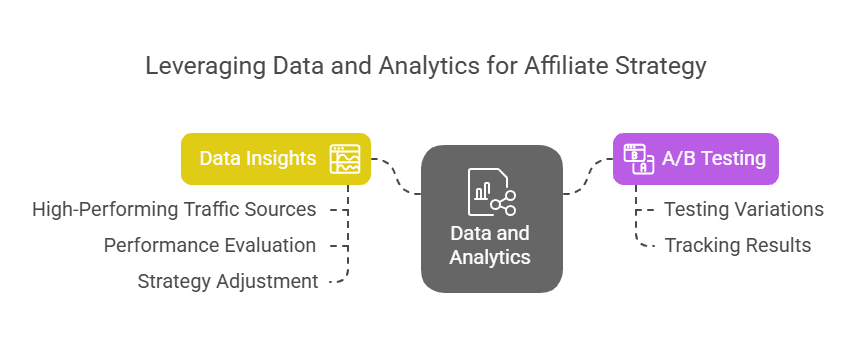How to Scale Your Affiliate Business: Diversifying Traffic Sources and Increasing Revenue Streams
Introduction
To scale your affiliate business, you need to find new ways to reach more people and increase earnings. The two most effective strategies? Diversifying your traffic sources and expanding your revenue streams.
Relying on just one traffic source or income stream is risky. What if your website’s search ranking drops? Or if a major affiliate program changes its commission structure? These scenarios highlight why you must scale your affiliate business by spreading out income sources and exploring new ways to attract customers.
In this guide, we’ll break down proven strategies to scale your affiliate business—from leveraging social media and paid ads to optimizing existing content and joining high-paying affiliate programs. With the right approach, you can grow sustainably and maximize profits.
1. Laying the Foundation for Scale
Before you start exploring new ways to get traffic and make money, you need to understand your current situation. Knowing what works and what doesn’t is key to making smart growth decisions.
Assessing Current Performance: What’s Working and What’s Not
Take a step back and look at your affiliate business. Check your analytics to see where most of your traffic and income come from. Ask yourself:
- Which traffic sources are bringing the most visitors?
- Which affiliate products or programs make the most money?
- Do certain types of content (blogs, videos, product comparisons) do better than others?
This isn’t just about finding your strengths. It’s also about spotting areas where you’re too dependent. Relying too much on organic traffic, for example, can be risky. By diversifying, you can reduce these risks and reach more people.
Analyzing Metrics and KPIs: Traffic Sources, Conversions, and Retention
Once you know where you stand, look closely at your key metrics. Your KPIs should include:
- Traffic Sources: The different sources bringing visitors to your site, such as organic search, social media, paid ads, and email.
- Conversion Rates: The percentage of visitors who click on your affiliate links and make a purchase.
- Retention and Repeat Visits: How often people come back to your site or engage with your content.
Understanding these numbers helps you know where to focus and where you can improve. Tools like Google Analytics, affiliate platform dashboards, and customer feedback can help you track these metrics.
Setting Realistic Goals for Growth and Scale
Before you start new strategies, set clear goals for growth. These goals could be:
- Increasing Total Traffic: Aim to grow traffic from both new and existing sources.
- Improving Conversion Rates: Work on getting more visitors to make purchases.
- Boosting Revenue per User (RPU): Look for ways to increase what each visitor earns by suggesting higher-priced items or product bundles.
Goals help guide your efforts. They give you a way to measure the success of each scaling strategy.
2. Diversifying Traffic Sources
To grow, start by reaching more people. This section will explore ways to do this, including paid and organic methods.

A. Organic Traffic Expansion
Organic traffic, mainly from SEO, is a treasure for affiliate marketers. It offers lasting results. To grow organic traffic, create quality content that ranks well and appeals to your audience.
- Building Long-Term SEO Strategies
- First, check your current SEO setup. Are you using the right keywords for your niche? A detailed SEO audit can show where you can improve or create new content.
- Target both high-volume, competitive keywords and specific, less competitive ones. This mix helps you win quickly with lower-competition terms while building authority on more competitive ones.
2. Content Diversification: Blogs, Video Content, and Podcasts
- If you mainly blog, try videos and podcasts too. Videos can be shared on YouTube, boosting your SEO. Podcasts can reach new listeners on Apple, Spotify, and Google.
- Turn your best content into different formats. For example, make a video from a popular blog post. This can increase its impact and reach.
3. Enhancing Keyword Targeting and Topical Authority
- Instead of just targeting keywords, focus on topics. For example, if your niche is “kitchen gadgets,” write about subtopics like “best blenders,” “food processors,” and “juicers.” This makes your content more valuable to search engines.
B. Paid Traffic Channels
Paid ads can quickly boost your traffic. They require an investment but can significantly increase your earnings when used right.
- Introduction to Paid Ads: Facebook, Google Ads, and Bing
- The main players for paid ads are Facebook Ads, Google Ads, and Bing Ads. Each offers unique ways to target specific audiences or search intents.
- Facebook Ads are great for visually appealing products. Google Ads are perfect for capturing people actively searching for products. Bing Ads can offer lower-cost clicks and conversions.
2. Optimizing Ad Spend and Improving ROI
- Tracking and optimization are key when working with paid ads. Use A/B testing to see which ads perform better. Adjust your targeting based on age, location, interests, and other demographics. Split tests on ad copy, imagery, and landing pages can reveal the elements that generate the highest ROI.
- Start with a modest budget, evaluate the performance, and scale up on ads that demonstrate consistent profitability.
3. Experimenting with Social Media Ads, Retargeting, and Display Advertising
- Social media ads can go beyond Facebook to platforms like Instagram, Twitter, LinkedIn, and even TikTok. Each platform has its unique advantages; Instagram is great for lifestyle products, while LinkedIn may work better for B2B.
- Retargeting ads help capture people who visited your website but didn’t convert. By reminding them of the product or offer they looked at, you increase the chances of a conversion.
C. Social Media as a Traffic Source
Social media offers both paid and organic avenues for scaling traffic. Each platform has its strengths, and the right strategy can lead to impressive growth without paid ads.
- Strategies for Organic Social Media Growth (Instagram, Twitter, TikTok)
- Building a presence on social platforms allows you to reach audiences more personally. Sharing valuable content, user-generated posts, and engaging with followers builds trust and positions you as a go-to source for your niche.
- TikTok, with its fast-growing popularity, is great for reaching younger audiences, if your niche includes trendy, visually engaging products.
2. Best Practices for Community Engagement and Content Creation
- Respond to comments, share follower posts, and run polls or Q&As. Creating a sense of community not only keeps followers engaged but also encourages them to share your content, which can organically bring new traffic.
- When posting, use a mix of content types—educational, entertaining, and promotional—to keep the audience interested and engaged.
3. Collaborating with Influencers for Enhanced Reach
- Partnering with influencers lets you leverage their audience. Micro-influencers (with smaller, but highly engaged followings) are often more cost-effective and authentic for niche products.
- Many influencers offer affiliate partnerships, where they receive a commission based on conversions. This can create a win-win relationship that boosts your traffic and sales.
D. Emerging Platforms and Niches
As the digital landscape evolves, so do the platforms that people use. To stay ahead of the competition, consider exploring newer or niche platforms to capture audiences that might not be as easily reachable through traditional means.
- Experimenting with New and Upcoming Platforms (Pinterest, Reddit, etc.)
- Pinterest: Known for its high conversion rates, Pinterest is powerful for visual niches like fashion, beauty, home decor, and DIY projects. With Pinterest’s search functionality, users actively seek inspiration and products, making it a prime source for affiliate traffic.
- Reddit: With numerous niche communities, Reddit is a goldmine for affiliates who know their target audience’s interests. But, engaging on Reddit requires authenticity; blatant self-promotion is often frowned upon. Instead, participate in discussions, provide genuine advice, and share affiliate links sparingly.
2. Leveraging Niche Communities and Discussion Forums
- Specialized forums, like Quora or even industry-specific forums, allow affiliates to target highly specific audiences with relevant content. Answering questions with value-added responses can lead users to your site for further information.
- Niche Facebook Groups: Whether they’re your groups or ones you participate in, niche groups allow you to target audiences based on shared interests. Building a group around a particular niche (like travel hacking or minimalist tech) can create an active community that values your recommendations.
3. Strategies for Gaining Traction on Less Saturated Platforms
- Content Tailoring: Adjust your content style to match each platform’s tone. Reddit prefers casual, discussion-oriented posts, while Pinterest thrives on high-quality visuals and actionable steps.
- Consistent Engagement: Regularly participate in these communities without always linking back to your site. This builds your reputation as a knowledgeable resource, increasing the chances that users will seek out your content naturally.
3. Enhancing Existing Revenue Streams
Once you have diversified your traffic sources, the next step is to maximize revenue from your current channels. Increasing the revenue generated from your existing traffic can significantly boost profits without requiring new visitors.

A. Optimizing Product Recommendations
Offering the right products to the right audience is critical for affiliate success. Instead of promoting a broad range of products, focus on high-quality recommendations that are likely to resonate with your target audience.
- Data-Driven Approaches to Improve Product Selections
- Use data insights to identify which products your audience engages with most. Look at metrics like click-through rates and conversion rates to see which products attract the most interest.
- Implement A/B testing for product placements, images, and descriptions to determine which variations drive more clicks and conversions.
2. Utilizing Customer Feedback to Refine Offerings
- Encourage feedback through email surveys, comments, or even social media polls to learn more about your audience’s preferences. If you’re promoting gadgets, for example, find out if your audience values durability over aesthetics or vice versa.
- This information allows you to fine-tune your product recommendations, offering items that closely match your audience’s needs.
3. Testing and Comparing Conversion Rates of Various Products
- Experiment with different product categories or brands to find high-converting items. Consider promoting higher-ticket items with attractive commission rates, as these can yield substantial earnings from a single sale.
- Periodically rotate your offerings and keep track of changes in conversion rates to see if particular products perform better during specific seasons or times.
B. Increasing Average Order Value (AOV)
Increasing the average amount each customer spends can be a game-changer in affiliate marketing. Here are some ways to boost AOV and maximize your earnings per transaction.
- Upselling and Cross-Selling Techniques
- When recommending a product, suggest complementary items as well. For example, if you’re promoting a camera, recommend a bundle that includes a lens, tripod, and memory card.
- Create content that naturally encourages bundled purchases, like “Must-Have Accessories for [Product]” or “Ultimate Kit for [Audience Need].” Affiliate links to multiple related products in these bundles can increase the total sale value.
2. Bundling Offers or Adding Bonus Content
- Bundling works well in niches where customers need various products. For example, fitness affiliates can bundle workout plans with nutritional supplements.
- Offering bonus content like e-books, guides, or exclusive tutorials as part of a product bundle can encourage customers to buy through your affiliate links.
3. Leveraging High-Ticket Products for Premium Affiliate Payouts
- High-ticket products may not convert as easily as cheaper items. But when they do, they bring in more commission. Test if your audience likes premium items in your niche, like high-end electronics or exclusive online courses.
- To support sales of high-ticket items, create detailed, comparative reviews. Highlight the unique benefits and features of premium products.
C. Improving Conversion Rates
Once traffic reaches your site, focus on improving the conversion rate. This maximizes the revenue from existing visitors.
- A/B Testing Landing Pages and CTA Buttons
- Regular A/B testing of landing pages is key for better conversion rates. Try different layouts, button colors, CTA texts, and images to see what works best.
- Even small changes can have a big impact. Try changing the color of your CTA button or its placement to see if it boosts clicks and purchases.
2. Creating More Persuasive Content
- Persuasive content isn’t always “salesy.” It’s about aligning with what readers want. Identify their pain points and explain how your recommendations can help.
- Use storytelling in your product reviews or blogs. Stories about how a product solved a problem can help readers see its value.
3. Crafting Better-Targeted and Personalized Offers
- Personalization can greatly improve conversion rates. Use retargeting tools to show personalized offers based on site interactions.
- Use email retargeting to reach users who visited but didn’t buy. Send follow-up offers, discounts, or personalized recommendations based on their browsing.
4. Adding New Revenue Streams
Diversifying income is key for a stable affiliate business. Adding new revenue streams helps balance out ups and downs. This includes seasonal trends or changes in program performance.

A. Exploring Multiple Affiliate Programs
Dependence on one affiliate program is risky. Expanding your partnerships reduces risks. It also opens doors to higher commissions or special offers.
- Introduction to Joining Multiple Affiliate Networks
- Start by finding new affiliate networks and programs that fit your audience’s needs. Networks like ShareASale, CJ Affiliate, and Rakuten offer a wide range of products.
- Look into niche networks that focus on specific products or services for your audience. These programs often have higher commissions because they target a specific market.
2. Evaluating Networks and Affiliate Managers
- Don’t just look at commission rates. Consider cookie duration, payment frequency, and tracking reliability too. These factors can greatly affect your earnings.
- Build good relationships with affiliate managers. They might offer exclusive deals, bonuses, or promotions to top performers, boosting your earnings.
3. Choosing Programs That Align with Audience Needs
- Know what your audience wants and choose programs that match. Relevant, high-quality products improve your credibility and lead to better engagement.
- Use data from surveys or social media to see what your audience is interested in. This helps you choose the right products to recommend.
B. Selling Digital Products
As an affiliate, you already have a built-in audience and content expertise. Use this to create digital products that complement your affiliate recommendations.
- Creating Digital Products Like E-Books, Courses, or Guides
- If you’re an expert in a specific area, turn that into a digital product. E-books, online courses, or guides require upfront effort but can earn passive income over time.
- For example, a fitness affiliate could make a workout plan e-book. A tech affiliate might create a guide on optimizing computer performance.
2. Strategies for Packaging Content Based on Affiliate Knowledge
- Package your digital products with affiliate links. If you sell an e-book, include links to tools or products mentioned in the content. This adds value and boosts affiliate earnings.
- Digital products can also attract new users to your website. This can lead to more people discovering affiliate products.
3. Combining Product Sales with Affiliate Recommendations
- Create digital products that align with your affiliate promotions. For example, a recipe e-book could include affiliate links for ingredients or kitchen tools.
- Combining paid products with affiliate links maximizes your earnings. It also adds value to your audience, creating a diverse revenue stream.
Adding diverse revenue streams makes your affiliate business more resilient. It allows you to adapt as markets change and build a stronger income model.
C. Launching Subscription Services
Subscription-based services are getting more popular for affiliates. They offer a steady income. Starting a subscription model takes time and effort but can be very profitable if you keep your audience engaged.
- Building Recurring Income through Subscriptions
- Starting a subscription model in your niche can be anything from exclusive content to a membership program with premium resources. For example, an affiliate in the personal finance niche could offer a subscription for weekly stock tips or market analysis.
- Set your prices based on the value of what you’re offering. Monthly memberships, where customers pay a small fee for premium content, create a steady income stream.
2. Examples of Subscription Models that Fit Affiliate Businesses
- Premium Content Access: Offer exclusive blog posts, videos, or live Q&As. This is great in niches where insider knowledge is valuable, like investing, tech, or health.
- Tool Kits or Resource Libraries: Offer toolkits, templates, or resources your audience would pay for (e.g., graphic design templates for a creative niche). This keeps subscribers engaged.
3. Tips for Maintaining Subscriber Engagement and Loyalty
- To keep subscribers, update regularly and add value. Talk to your subscribers, sharing exclusive tips, behind-the-scenes content, or subscriber-only discounts.
- Also, ask for feedback from subscribers. See what they value most and what they’d like more of. This helps you tailor your content to keep them interested.
5. Leveraging Data and Analytics for Scale
Data is key to scaling your affiliate strategy. By understanding and using analytics, you can see what works and what doesn’t. This lets you optimize every part of your process for better results.

A. Using Tools like Google Analytics and Affiliate Dashboards for Data Insights
- Identifying High-Performing Traffic Sources
- Google Analytics shows where your traffic comes from and which sources lead to the most conversions. By looking at traffic sources like search engines, social media, and referral links, you can see where your audience is most engaged.
- Most affiliate dashboards also give conversion data for individual links. This shows which links drive the most sales, helping you focus on the products or pages with the highest impact.
2. Evaluating Performance of Different Traffic Sources
- Once you know which sources bring in the most visitors, dive deeper to assess the quality of that traffic. Look at metrics like average session duration, bounce rate, and pages per session to see how engaged users are.
- If you have a high bounce rate, it might mean your landing pages need work. If visitors are leaving quickly, consider adjusting the page layout, adding more engaging content, or reworking calls-to-action (CTAs).
3. Using Data to Adjust Strategies, Pivot Traffic Sources, and Improve ROI
- Analytics help you make informed decisions, adjusting your efforts based on performance. For example, if certain content types like product reviews consistently outperform listicles, you can shift focus to those.
- Use data to fine-tune paid ads, experiment with SEO strategies, and test new platforms. Small tweaks based on your insights can improve conversions and increase ROI over time.
B. Conducting A/B Testing for Continuous Improvement
- Testing Variations of Key Elements
- Keep testing things like headlines, CTA buttons, and page layouts. See what works best with your audience. This is called A/B testing. It helps make your site better for users and boosts sales.
- Try different versions of the same page to find what sells the most. For example, changing CTA button colors or link phrases can make a big difference.
2.Tracking Results and Iterating
- Watch each test closely over time to get reliable data. Pick the best version and keep tweaking small things to keep your site top-notch.
- A/B testing isn’t just for web pages. Try it with email campaigns, social media, or even different content types like videos or written reviews.
6. Building Partnerships for Long-Term Growth
Working with other affiliates, brands, and influencers can really help you grow. It lets you reach more people and use shared resources.
Networking with Other Affiliates for Mutual Growth
- Benefits of Affiliate Networking
- Networking with other affiliates keeps you in the loop on industry trends. You can learn about new programs and share marketing tips. A strong network also offers support for working together or sharing audiences.
- Join affiliate groups on Facebook or LinkedIn, or go to affiliate marketing conferences. This is a great way to meet others and grow your network.
2. Cross-Promoting with Complementary Affiliates
- Work with affiliates who have a similar audience but offer different products. For example, if you promote fitness gear, team up with a nutrition affiliate for mutual benefits.
- By promoting each other’s content, you can reach more people without spending on ads. Use email lists, social media, or guest posts.
Collaborating with Brands for Exclusive Deals or Sponsorships
- Forming Partnerships for Unique Offers
- Exclusive deals make your affiliate links more appealing. Work with brands to get special discounts or limited-time offers. This sets you apart from others.
- Sponsorships offer more than just commissions. Brands might pay for product reviews, blog posts, or email features. This adds to your income and strengthens your brand relationship.
2. How Partnerships Can Open New Traffic Channels and Revenue Streams
- Brand partnerships can lead to unique promotional chances. A company might share your content on its social channels, bringing its followers to your site.
- Long-term partnerships build trust with your audience. This can lead to more sales over time.
7. Conclusion and Final Tips
Scaling an affiliate business means growing wisely and adjusting to new chances as they come. By spreading out your traffic and income sources, you make your business stronger. It’s less likely to be hurt by changes in the market or a drop in one area’s success.
Here are some important tips for growing your affiliate business:
- Keep Experimenting: Always try new ways to get traffic, ads, and content. This keeps you ahead.
- Use Data to Drive Decisions: Let numbers guide your choices. This makes sure your efforts are effective.
- Focus on Adding Value: Your audience’s trust is key. Always give them real advice and useful info.
In today’s fast-changing digital world, being flexible is crucial. With a forward-thinking, data-based plan, you can turn a successful affiliate business into a big, multi-channel success. Follow these tips, stay consistent, and keep looking for new ways to grow. Your business’s potential is limitless if you’re ready to innovate.
Sources
- Neil Patel’s Blog on Affiliate Marketing
Title: The Ultimate Guide to Affiliate Marketing
URL: https://neilpatel.com/what-is-affiliate-marketing/
- Ahrefs Blog on SEO and Affiliate Marketing
Title: Affiliate Marketing: The Complete Guide for Beginners
URL: https://ahrefs.com/blog/affiliate-marketing/
- HubSpot Blog on Conversion Rate Optimization
Title: 10 Ways to Increase Your Conversion Rate
URL: https://blog.hubspot.com/marketing/conversion-rate-optimization
- Backlinko’s Definitive Guide to SEO
Title: The Definitive Guide to SEO in 2023
URL: https://backlinko.com/seo-guide
- Authority Hacker’s Guide to Building Profitable Affiliate Sites
Title: How to Start a Profitable Authority Site (Step-by-Step)
URL: https://www.authorityhacker.com/authority-site/
- Social Media Examiner on Using Social Media for Business
Title: How to Use Social Media for Business: A Beginner’s Guide
URL: https://www.socialmediaexaminer.com/how-to-use-social-media-for-business/
- Affiliate Summit’s Industry Insights
Title: Affiliate Marketing Industry Reports
URL: https://www.affiliatesummit.com/resources
- Google Analytics Academy for Data-Driven Marketing
Title: Google Analytics for Beginners
URL: https://analytics.google.com/analytics/academy/course/6
- Amazon Associates Blog on Affiliate Marketing Optimization